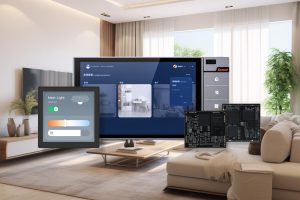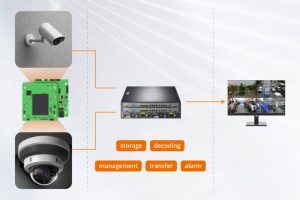How does the Bluetooth roaming gateway help IoT healthcare? On one hand, there are always a lot of patients in the hospital, and accordingly huge amounts of wards in order to match the needs of medical treatment. Sometimes, the patient needs to go from the ward to the medical examination room due to medical needs, or from the ward to the restaurant due to the patient’s own needs, or even when going out for a walk. In short, patients will move within the hospital.
On the other hand, for some critically ill patients, their vital signs need to be monitored at all times, such as blood sugar, blood oxygen, blood pressure, etc., to prevent accidents. A Dusun IoT expert once said that he suffered from a hyperglycemia emergency and needed to be hospitalized. The nurse would measure the blood sugar level at least 7 times a day. he might become very weak, because the blood sugar level tends to get too low, especially in the middle of the night. Therefore, 24-hour remote patient monitoring is highly required. However, such high-frequency hospital patient monitoring increases the burden on nurses.
Thanks to above two reason, the hospital is recommended to be covered with Bluetooth gateways to connect their telehealth monitoring devices to the internet, which can upload vital sign data to the network server in real time. And then, doctors and nurses can use the software to remotely monitor patient’s blood sugar fluctuations and trends throughout the day, reducing the pressure and improving the efficiency of healthcare providers.
Usually these remote vital sign monitoring is completed by wearable Bluetooth devices, but there is a problem: Although there are traditional Bluetooth gateways that can help upload patient vital signs data, once the patient moves and the data leaves the range of the Bluetooth gateway, the data may be lost, RPM remote patient monitoring may be disrupted. In order to solve this problem, Bluetooth roaming gateways are needed to make a seamless Bluetooth coverage. When the patient is moving in the hospital, these vital sign data can also be transmitted to the monitoring center of the hospital without interruption, so that doctors and nurses can watch data and keep records at any time. This is the meaning of the existence of the Bluetooth roaming gateway. It can increase the activity range of patients, improve the quality of patient life, reduce the workload of medical staff, and provide more accurate data for doctors to make medical decisions, which is of great value.
What is Bluetooth Roaming
In simple words, Bluetooth roaming is a technology supporting seamless, high-quality connectivity throughout the entire Bluetooth communication process. Compared with regular Bluetooth communication, Bluetooth roaming technology is helpful to ensure stable Bluetooth data communication while the sub-device is moving from one location to another.


In detail, “roaming” literally means to walk around freely and move freely. For application developers, roaming includes two meanings. One is wireless roaming. When there are multiple APs in the network, and there is a certain overlap between each micro-unit, wireless users can move within the entire WLAN coverage area. The wireless network card can automatically find the AP with the highest signal strength nearby, and send and receive data through this AP, maintaining an uninterrupted network connection, which is called wireless roaming.
The second is seamless roaming. What seamless roaming can do is to control the switching time between APs at the millisecond level, so there is basically no packet loss, and almost no pause in the communication.
Bluetooth roaming refers to when a Bluetooth terminal moves from the coverage of a Bluetooth gateway to the next Bluetooth gateway, it automatically switches to the next Bluetooth gateway with a stronger Bluetooth signal. process. Bluetooth roaming is seamless roaming. It is suitable for some places have very large areas and have very strict requirements on communication quality. It is not expected to have any interruption when switching between APs.
Bluetooth Roaming vs Cellular/Wi-Fi Roaming
Sounds like Bluetooth roaming has some similarities with Cellular wireless network roaming (4G/5G) and Wi-Fi roaming, so what is the difference? When cellular and Wi-Fi technologies were invented and designed, they took roaming into consideration. Moreover, for cellular networks and Wi-Fi, roaming is usually initiated by mobile clients’ terminals, such as mobile phones. When you are driving from city A to city B, and you have been making a call on the highway, and this call lasts for a long time, you may feel that the call has been going on without any interruption, that is because In fact, there have been many roaming switchings in the entire process. On the highway from city A to city B, there are many cellular base stations, and its coverage will change from one cellular base station to another as you drive. thanks to both your phone and these cell sites support roaming, it’s going to have a smooth handoff and transition. So you’re on the phone without realizing that roaming is happening so many times. This scenario is a relatively successful roam.
But Bluetooth was invented to solve short-distance communication, so the Bluetooth protocol itself does not support Bluetooth roaming, nor does it have the concept of Bluetooth roaming. Secondly, the vast majority of Bluetooth terminal devices, such as wearable devices and various sensors, have extremely limited computing power and storage capacity in order to save power and reduce costs, and there is no way to supports very complex roaming protocols, that’s why it has no ability to initiate Bluetooth roaming requests. The thirdly and more important reason is that the most important applications of Bluetooth is BLE, which requires a long battery life, this also limits the terminal’s ability to support complex Bluetooth roaming. So for Bluetooth, it has no way to rely on the Bluetooth terminal to initiate roaming switching. So this is the biggest difference between Bluetooth roaming and cellular WiFi roaming.
Therefore, if we need to support Bluetooth roaming, there are two ways, one is to change the Bluetooth protocol and change the Bluetooth terminal. This is very unrealistic, and the cost and time required are huge. The second way is to find a way to solve this problem in the Bluetooth base station without changing the Bluetooth protocol and the terminal. The Bluetooth Roaming Gateway was born.
Bluetooth Roaming Uses
The most typical and emerging application of Bluetooth roaming gateway occurs in hospitals. The Bluetooth devices in the hospital are widely used. By wearing Bluetooth remote patient monitoring wearables such like body temperature stickers, ECG stickers, oximeters and other Bluetooth vital sign monitoring devices for patients, their data will be automatically transmitted to the Bluetooth gateway, and the Bluetooth gateway will collect the data via Wi-Fi. , Ethernet, 4G or 5G to send back to the user server to realize real-time synchronization of data, and doctors and nurses can check the physical vatal signs data on computers or handheld devices.
Can it be used in other places besides hospitals? Of course Yes, there are already a wide range of BLE devices application scenarios such as education, industrial automation, elderly care, sports, fitness, and asset tracking, but they generally stay at the entry level, or cannot move freely, or cannot roam. It is inconvenient for data aggregation, and not conducive to network management. If these BLE devices can be upgraded by using Bluetooth roaming gateway technology, it will bring huge surprises to the entire industry!
Technical Working Principle of Bluetooth Roaming
In the Bluetooth low-energy wireless communication system, the Bluetooth secondary node can send Bluetooth signals to the Bluetooth master node by broadcasting or exchanging data with the Bluetooth master node. In this procedure, if the Bluetooth master node signal strength is weak, or Bluetooth from the position of the mobile node with the Bluetooth master node distance is beyond the scope of the wireless signal, both can lead to Bluetooth disconnection between the master node and slave node. In this way, both nodes need to be reconnected.
As the following block diagram shows, the Central’s Host (Host A) may change the connection link key using the HCI_Change_Connection_Link_Key command. A new link key will be generated and the Hosts will be notified of this new link key.
However, suppose there is data transmitted in the connection gap between the Bluetooth master node and the Bluetooth slave node. In that case, the data will be lost, affecting the normal communication between the Bluetooth master node and the Bluetooth slave node.

Anyone who knows Bluetooth also knows that the connection of Bluetooth devices requires security authentication and pairing. From the perspective of a Bluetooth terminal, it usually has some security requirements after it enters the Bluetooth coverage area. It needs to perform pairing and security authentication with the Bluetooth gateway. Next, when the Bluetooth terminal moves within the Bluetooth coverage area, the pairing needs to be updated continuously, because it will move from the coverage area of one Bluetooth base station to the next. Under normal circumstances, some human intervention is required. But the Bluetooth roaming gateway eliminates this layer of intervention.
When you are covered with Dusun IoT’s Bluetooth roaming gateways in the hospital, all the Bluetooth gateways will cooperate with each other. For the incoming Bluetooth terminal, it seems to be dealing with the same Bluetooth gateway all the time. Because that the re-pairing and security authentication just mentioned are all avoided, the entire Bluetooth roaming switch will become very fast, safe, and smooth. The Bluetooth device’s data uploading will not be affected while switching between different gateways.
In the process of Bluetooth roaming handover, there is no need to re-secure the handshake and re-Bluetooth pairing. The user’s service connection is maintained during Bluetooth roaming without human intervention or changes to the Bluetooth protocol and terminal.
Bluetooth Roaming Features
- Ensure continuity of service connections during Bluetooth roaming
- Ensure seamless, fast, and secure Bluetooth roaming without any people intervention
- No need to change the Bluetooth protocol and terminal device
- Always ensure device safety and system security
- Bluetooth Roaming can be applied to any Bluetooth IoT application that needs to roam
Dusun IoT Bluetooth Roaming Solution Introduction
For some smart hospitals requiring high real-time data transmission performance, the traditional Bluetooth gateway may not fit the demands. Dusun IoT developed a seamless Bluetooth roaming gateway network mechanism to obtain the patient’s real-time body status. It would upload the health data to a cloud server with low latency in less than 1s, even the patients moving in the building’s every corner.
During the process of Bluetooth roaming, there is no need to re-handshake or re-pair Bluetooth, and the user-device connection is still maintained without any manual intervention or changes to the Bluetooth protocol and Bluetooth terminal. Thus, the telemonitoring devices require no manual operation to migrate from one Bluetooth gateway to another.
At the same time, patients move into the hospital, and their physiological status of patients would be uploaded to the cloud server in real-time.

Remote Patient Monitoring Device Solution
Dusun IoT proposes an remote health monitoring system centralized with Bluetooth gateway for monitoring patients in remote areas, aiming at the increasing demand of the health care industry. Currently, three different Bluetooth gateway models for the different scenarios are ready for implementation: the standard RPM gateway, Bluetooth roaming gateway, and Parkinson gateway.

Remote Patient Monitoring Devices List
Plenty of commonly used IoMT devices have been integrated with the Bluetoothgateways, part of them are listed below,
- Bluetooth Thermometer
- Bluetooth Oximeter
- Bluetooth Blood Pressure Monitor
- Bluetooth Glucose Meter
- Bluetooth Weight Scale
- Bluetooth Heart Rate Straps
- Bluetooth Heart Rate Bracelets
- Bluetooth ECG Devices
- SOS Button
- Bluetooth Temperature Monitor Bracelet
- Smart Pill Box
- Fall Detector


















